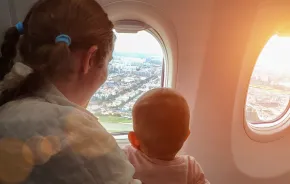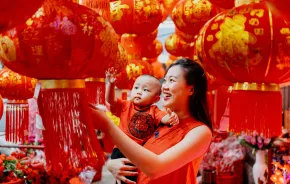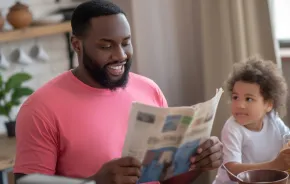
Photo:
The Oldenburg family (from left: Winter, Robyn and Nasia) | Credit: Dave Thomas Foundation for Adoption
In Washington state, there are more than 3,500 children in the foster system waiting to be adopted. The purpose of the foster care system is to provide a temporary safe place for children when their family cannot provide one, and nearly two-thirds of the children who exit the foster care system each year are reuniting with their families. But sometimes parents don’t make progress toward creating a safe home for their children and the state terminates their parental rights. When that happens, children in foster care become legal orphans in need of an adoptive family. Every year in Washington, more than 200 of them reach the age of 18 and exit the system without ever finding a family to belong to.
Children at risk
“About 20,000 kids age out of foster care each year in America,” says Rita Soronen, president and CEO of the Dave Thomas Foundation for Adoption. “They are at much higher risk for negative consequences without the safety net of family.” Enter Wendy’s Wonderful Kids (WWK), the signature program of the Dave Thomas Foundation, the only public nonprofit charity in the United States focused exclusively on foster care adoption. WWK is a grant-based program to hire recruiters who use an evidence-based, child-focused recruitment model to find loving, permanent homes for children waiting in foster care. The program focuses on those children who are at most risk of aging out of the system, whether due to their age, special needs or belonging to a sibling group.
“Past the age of 9, the likelihood of adoption drops significantly,” says Soronen. In Washington, 34 percent of adoptable foster children are between the ages of 9–17, but that age group makes up only 24 percent of adoptions.
“Sixteen or 17 is not too old to be adopted. The reality is that we need family over our whole life,” says Courtney Angeles, director of adoption services at Children’s Home Society of Washington (CHSW).
Wendy’s Wonderful Kids in Washington
WWK launched in 2004 in Washington and a few other states. When the program expanded in 2017, Washington state was one of the first to scale up its operations. Today, there are 12 recruiters working with the 214 Washington kids enrolled in the program. “We provide support to state social workers,” says Angeles. CHSW, the state’s oldest and largest child welfare nonprofit, administers WWK in Washington through a public/private partnership funded by the state and the Dave Thomas Foundation.
The program has three components. “First, there is the recruiter’s relationship with the child,” Angeles says. Building the relationship begins with the social worker studying each child’s records to find out what their needs are and to identify adults with whom the child has made a connection in the past. It also means meeting with them personally, getting to know their personality and helping them understand the adoption process.
The second part is the search for an adoptive family. “We look for adults in the child’s life who may be open to adoption if they knew it was an option,” says Soronen. There is evidence that placements, where children have a preexisting connection, are more likely to be successful, but it’s not a program requirement. “Not all of Wendy’s Wonderful Kids end up with someone who already knows them,” says Soronen.
The third component is network building. Being moved among foster homes can be disruptive and isolating, and care providers are often unaware of what other agencies are doing. “We plant seeds and make connections, even helping kids engage in extracurricular activities,” says Angeles. “People tend to pathologize foster kids who are processing grief and trauma.” Kids coming out of the foster system are twice as likely to have PTSD as veterans. Connecting with all the adults in a child’s life can break down silos and provide more coordinated responses to kids’ needs. This intensive process is possible because WWK recruiters work with only 12–15 active cases at a time, half as many as state social workers may have to manage.
Finding families
This child-centered approach has proven remarkably successful at finding families for children who need them. During the pre-expansion years, working with only two recruiters, WWK finalized 243 permanent placements. Since expanding the program in 2017, they have matched 80 kids with permanent families.
Angeles says that one of the challenges to finding families is the continuing myth that family structure is a criterion for adoption. Marital status, sexual orientation, age and race are not obstacles to adopting a child in the foster system. Even income need not be a barrier — programs mitigate adoption costs and financial assistance is available for dealing with special needs post-adoption. The only requirement is to provide a safe, loving home. “Kids just need someone to love them and support them,” says Angeles.
Making your matchIf you think you might be a match for a child in foster care — whether you have already met them or not — Soronen has some advice. “We encourage people to do as much research as possible,” she says. Prospective parents should carefully consider their resources and support systems and evaluate their own strengths and weaknesses frankly.
|











